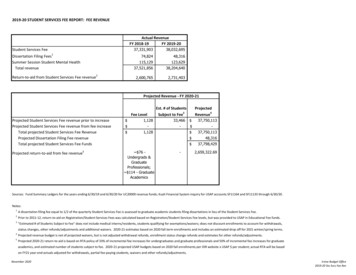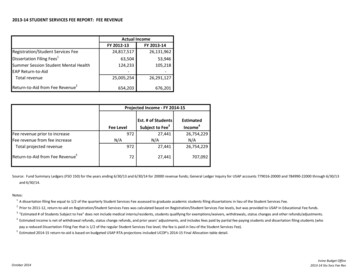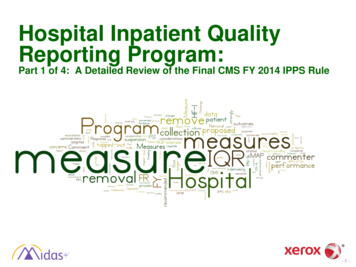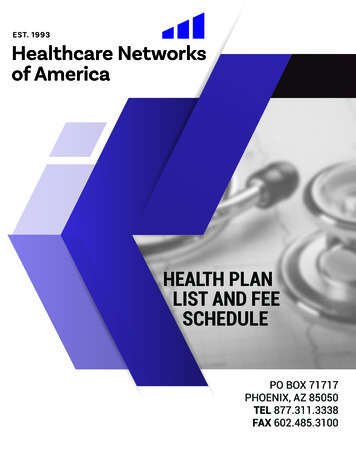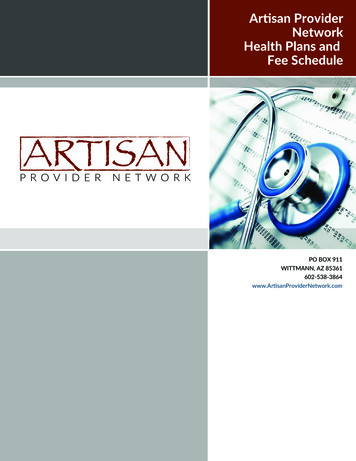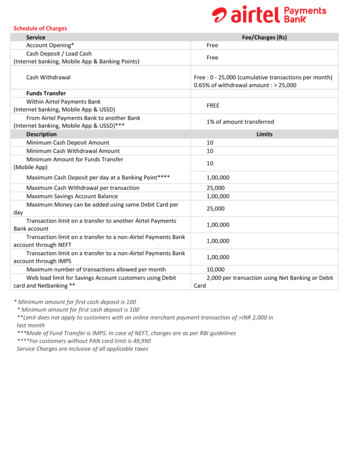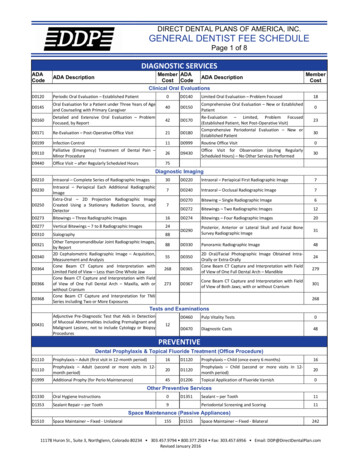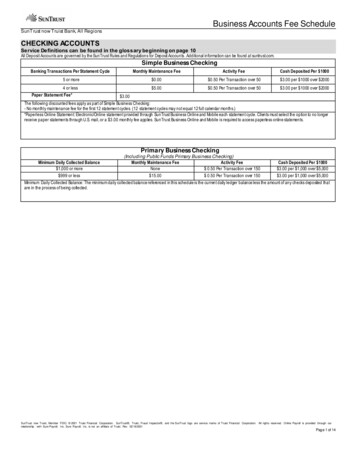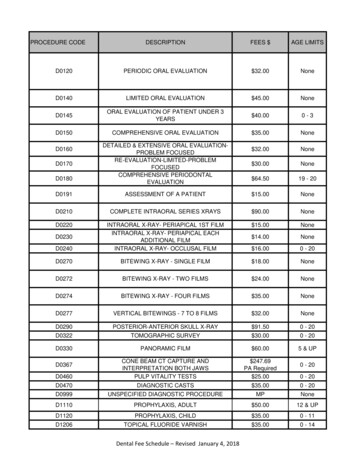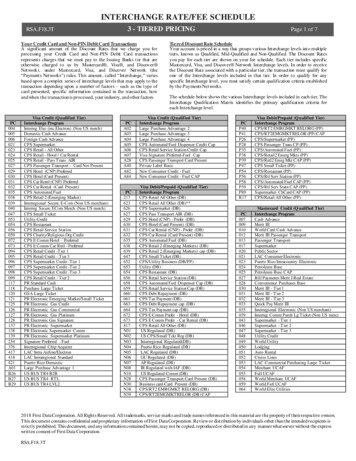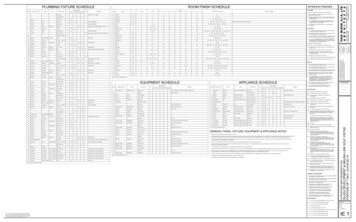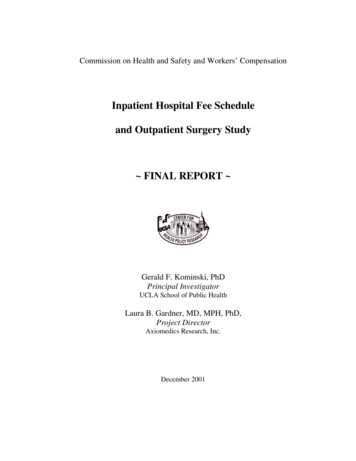
Transcription
Commission on Health and Safety and Workers’ CompensationInpatient Hospital Fee Scheduleand Outpatient Surgery Study FINAL REPORT Gerald F. Kominski, PhDPrincipal InvestigatorUCLA School of Public HealthLaura B. Gardner, MD, MPH, PhD,Project DirectorAxiomedics Research, Inc.December 2001
CHSWC Inpatient Hospital Fee Schedule and Outpatient Surgery StudyTable of ContentsExecutive Summary. 3CHSWC Inpatient Hospital Fee Schedule and Outpatient Surgery Study . 7I. Assessment of the Inpatient Hospital Fee Schedule . 8Study Aims . 8Background. 9History of the Workers’ Compensation Inpatient Hospital Fee Schedule. 9Issues with the Inpatient Hospital Fee Schedule . 13Data . 15Data Sources . 15Timeframe. 16Sector. 16Period. 17Sector by Period . 18Spine Surgery DRGs (DRGs 496-500). 18Exempt DRGs . 19Methods . 20Literature Review . 20Data Preparation. 23Case Mix Adjustment . 24Statistical and Modeling Analyses. 26Results . 28Statistical Analyses. 28Overall Cost Impact of the IHFS . 28Comparison of Provider Charges and IHFS Reimbursement for Workers’ Compensation Admissions. 30Comparison of IHFS and Group Health Reimbursement. 33Comparison of Resource Intensity between WC and Medicare Admissions. 40Modeling Analyses . 41Impact of Possible Changes to the IHFS on Future Payments to Providers . 41Recommendations . 47Inpatient Hospital Fee Schedule. 47Methodology for Determining Suggested Revisions to DRG Weights . 50System Costs with Revised DRG Weights. 52Adoption of New Technology . 53II. Evaluation of a Fee Schedule for Outpatient Surgery Facility Fees . 56Study Aims . 56Background. 56Medicare Outpatient Payment Systems. 56Ambulatory Surgery Center (ASC) Fee Schedule . 57Ambulatory Payment Classifications or APCs . 59Data . 61Data Sources . 61Time Frame. 61Descriptive Analyses . 62Methods . 63Literature Review . 63Data Preparation. 63v.6.1,12/03/013:03 PM*** DRAFT–DO NOT DUPLICATE OR CIRCULATE ***p. 1
CHSWC Inpatient Hospital Fee Scheduleand Outpatient Surgery StudyDecember 2001Results . 64Costs Related to Outpatient Surgery Facility Fees . 64Impact of a Fee Schedule for Outpatient Surgery Facility Fees . 67Medicare’s Ambulatory Surgery Center (ASC) Fee Schedule . 67Medicare’s Ambulatory Payment Classification (APC) System. 70Additional Modeling Analyses Using Variations of the ASC and APC Fee Schedules. 72Recommendations . 76System Savings with Outpatient Surgery Facility Fee Schedule . 78Overall Conclusions . 80References . 81v.6.1,12/03/013:03 PM*** DRAFT–DO NOT DUPLICATE OR CIRCULATE ***p. 2
CHSWC Inpatient Hospital Fee Scheduleand Outpatient Surgery StudyDecember 2001Executive SummaryThe Inpatient Hospital Fee Schedule and Outpatient Surgery study was initiated by theCommission on Health and Safety and Workers’ Compensation to provide information oncosts and areas of improvement related to the 1999 California Workers’ CompensationInpatient Hospital Fee Schedule (IHFS) and to evaluate the appropriateness of a fee schedulefor outpatient surgery facility fees.Data sources for the study included: Office of Statewide Health Planning and Development (OSHPD) Public Data File Medical Bill Review Vendors Group Health Carriers and Self-Insureds Workers’ Compensation Carriers.Inpatient Hospital Fee Schedule AnalysisImpact of the IHFSInflation-adjusted, case-mix-adjusted charges for workers’ compensation (WC) admissions innon-exempt DRGs rose 7.3%, from an average of 24,307 in the pre-IHFS period to anaverage of 26,072 in the post-IHFS period. Workers’ compensation case-mix-adjusted paidamounts rose 4.0%, from an average of 9,267 in the pre-IHFS period to an average of 9,637 in the post-IHFS period. Among spine surgery DRGs (DRGs 496-500), WC chargesrose 10.0%, from an average of 31, 057 in the pre-IHFS period to an average of 34,150 inthe post-IHFS period, while payments were relatively unchanged ( 12,255 in the pre-IHFSperiod; 12,459 in the post-IHFS period.Comparison of IHFS and Group Health ReimbursementAcross all DRGs, case-mix-adjusted charges for post-IHFS period workers’ compensationadmissions were 26,072 compared with 25,047 for group health admissions. Paid amountsaveraged 9,637 for workers’ compensation admissions in the post-IHFS period comparedwith 7,428 for group health admissions, a difference of 2,208. Among spine surgery DRGs(DRGs 496-500), case-mix-adjusted charges were 34,150 and 32,066 for workers’compensation and group health admissions, respectively. Paid amounts averaged 12,459 forworkers’ compensation spine-related admissions in the post-IHFS period compared with 8,280 for group health spine-related admissions, a significant difference of 4,179.v.6.1,12/03/013:03 PM*** DRAFT–DO NOT DUPLICATE OR CIRCULATE ***p. 3
CHSWC Inpatient Hospital Fee Scheduleand Outpatient Surgery StudyDecember 2001Reimbursement as a percent of charges (“percent reimbursement”) was calculated bydividing the average paid amount by the average charge across all DRGs and for eachindividual DRG. On average, the percent reimbursement was equal to 37.0% for workers’compensation admissions and 29.7% for group health admissions. The range of percentreimbursement across all DRGs for WC admissions was from 10.4% to 100%.Comparison of Resource Intensity between WC and Medicare AdmissionsThere were 2.04 procedures per admission for Medicare compared with 1.95 procedures peradmission for WC. LOS was 5.71 days on average for Medicare admissions compared with5.04 days on average for WC admissions. These differences were statistically significant.Impact of Possible Changes to the IHFS on Future Payments to Providers:(1) Impact of Stop-Loss Payment Provisions for Selected Cost OutliersWhen this study was first conceptualized, the IHFS had no cost outlier provision. However,regulation passed since then implemented a cost outlier provision based largely on theformula used by Medicare. The analyses performed as part of this study used the currentoutlier formula as well as earlier provisional language that would have exempted theadmission from the fee schedule whenever charges exceeded five times the fee scheduleformula.The outlier provision that was enacted will add approximately 14 million, or 5.6% to totalcosts in the system. Approximately 3.7% of admissions were tagged as outliers under thisprovision. Had the earlier outlier language been enacted, with the admission exempted fromthe fee schedule whenever charges exceeded five time the fee schedule formula, over 16% ofthe admissions would have been tagged as “outliers” and the additional costs to the systemwould have been as much as 223 million, or an increase of as much as 87%.(2) Alternative Approaches to Payment for Selected DRGsThe current allowed amount, incorporating the current outlier formula, was compared withthe alternatives of paying 60%, 80% or 100% of billed charges. Compared with the currentpayment formula, paying for spine surgery DRGs (DRGs 496-500) at 60%, 80% or 100% ofcharges would add approximately 82 million, 146 million, or 210 million to the system,respectively.v.6.1,12/03/013:03 PM*** DRAFT–DO NOT DUPLICATE OR CIRCULATE ***p. 4
CHSWC Inpatient Hospital Fee Scheduleand Outpatient Surgery StudyDecember 2001(3) Exemption of high-technology hardware from the IHFSThe provision to pay separately for implantable hardware will add between 7.1 and 28.6million in costs to the system, depending on the incidence of use of the implantable hardwarewithin DRGs 496-500. These estimates are conservative.Outpatient Surgery Facility FeesThe outpatient data set comprised 14,017 procedures overall. Among the entire sample, theaverage billed and paid amounts were 3,217 and 1,482, respectively. The 53.9%difference between billed and paid was attributable to preferred provider network discountsor contracted payment rates.Medicare’s Ambulatory Surgery Center (ASC) Fee ScheduleRepricing the 9,108 facility payments using the ASC fee schedule would result in an averagepayment of 515, an 88% reduction off the original billed amount of 4,228 and anadditional 73% less than the observed paid amount of 1,918. Total reductions off theoriginal billed charges total of 38.5 million would equal 33.8 million.Medicare’s Ambulatory Payment Classification (APC) SystemRepricing the 14,017 facility payments to the APC fee schedule would result in an averagereimbursement of 640 dollars–an 80% reduction off the original billed amount of 3,217and an additional 57% savings compared with the average payment amount of 1,482. Totalreductions off the original billed charges of 45.1 million would equal 36.1 million.RecommendationsInpatient Hospital Fee ScheduleBased on the results of these analyses, the authors of this report recommend the followingwith respect to the IHFS: Continue the cost outlier provision as currently enacted, with annual re-evaluationto assess the percent of cases and dollars that are qualifying as outliersContinue to base inpatient hospital reimbursement on the Medicare InpatientHospital Fee Schedule using the DWC-revised DRG weights and the 1.20multiplierEliminate the exemption for implantable hardware and/or instrumentationv.6.1,12/03/013:03 PM*** DRAFT–DO NOT DUPLICATE OR CIRCULATE ***p. 5
CHSWC Inpatient Hospital Fee Scheduleand Outpatient Surgery StudyDecember 2001 Implement revised DRG weights for the seven DRGs where the IHFSreimbursement appears not to be equitable compared with the group health sectorEncourage the use of appropriate, nationally peer-reviewed selection criteria toreduce inappropriate utilization of implantable hardware and other medicaltechnologyRe-evaluate the DRG weights, the revisions suggested herein and the overallcomparison between WC and GH annually, based on updated data.Outpatient Surgery Facility FeesThe authors recommend the implementation of a fee schedule. One potential system onwhich the fee schedule could be based is the Ambulatory Payment Classification (APC)system, for the following reasons: The APC system is currently in place for Medicare patients in hospital outpatientdepartments; thus many facilities are already familiar with itThe APC system covers more procedure codes than the ASC fee schedule and hasexisting processes to update and groom the approved procedure inventoryAPCs have a more adaptive construct than the ASC fee schedule because thereare 158 groups rather than nineThe wage index is an equitable adjuster given highly variable labor andoperational costs across California.Having a fee schedule for outpatient surgery facility fees should encourage appropriatedecision-making regarding setting (inpatient vs. outpatient) for patients who need surgery.We recommend a wage index to adjust payment levels so that they are specific to eachfacility’s location.System Savings with Outpatient Surgery Facility Fee ScheduleThe Workers’ Compensation Insurance Rating Bureau (WCIRB) reports that total workers’compensation medical costs in 2000 for California were 2.9 billion. WCIRB and CWCIestimate that outpatient services typically make up 50% of all medical services and thatfacility fees are approximately 10% of the outpatient service sector. Applying middle andhigh-end reimbursement formulae to these projections creates an estimated range of savingsof between 49 and 108 million in Year 1 after implementation.v.6.1,12/03/013:03 PM*** DRAFT–DO NOT DUPLICATE OR CIRCULATE ***p. 6
CHSWC Inpatient Hospital Fee Scheduleand Outpatient Surgery StudyDecember 2001CHSWC Inpatient Hospital Fee Schedule and Outpatient Surgery StudyThe Inpatient Hospital Fee Schedule and Outpatient Surgery study was initiated by theCommission on Health and Safety and Workers’ Compensation to provide information oncosts and potential areas for improvement related to the 1999 California workers’compensation Inpatient Hospital Fee Schedule (IHFS) and to evaluate the appropriateness ofa fee schedule for outpatient surgery facility fees. This report is divided into two mainsections:I. Assessment of the Inpatient Hospital Fee ScheduleII. Evaluation of a Fee Schedule for Outpatient Surgery Facility Fees.Each section contains six main parts: Study Aims Background Data Methods Results Recommendations.The two sections of the report are then followed by a short discussion and the references.v.6.1,12/03/013:03 PM*** DRAFT–DO NOT DUPLICATE OR CIRCULATE ***p. 7
CHSWC Inpatient Hospital Fee Scheduleand Outpatient Surgery StudyDecember 2001I. Assessment of the Inpatient Hospital Fee ScheduleStudy AimsThe aims of the part of the study focusing on the California workers’ compensation InpatientHospital Fee Schedule (IHFS) were to: Describe the issues stemming from the current IHFS Analyze the overall cost impact of the IHFS Identify Diagnosis-Related Groups (DRGs) wherein there are the largest differencesbetween provider charges and IHFS reimbursement Identify DRGs wherein there are the largest differences between IHFS and group healthsector reimbursement Compare resource intensity between workers’ compensation admissions and Medicareadmissions (because the IHFS is based on the Medicare PPS fee schedule for inpatienthospitals) Analyze the impact of possible changes to the IHFS on future payments to providers Develop recommendations for revising the IHFS.v.6.1,12/03/013:03 PM*** DRAFT–DO NOT DUPLICATE OR CIRCULATE ***p. 8
CHSWC Inpatient Hospital Fee Scheduleand Outpatient Surgery StudyDecember 2001BackgroundHistory of the Workers’ Compensation Inpatient Hospital Fee ScheduleUntil the current Inpatient Hospital Fee Schedule (IHFS) became effective in April of 1999,the California workers' compensation system included an Official Medical Fee Schedule(OMFS) that covered physician services, but did not cover hospital facil
Medicare’s Ambulatory Surgery Center (ASC) Fee Schedule Repricing the 9,108 facility payments using the ASC fee schedule would result in an average payment of 515, an 88% reduction off the original billed amount of 4,228 and
